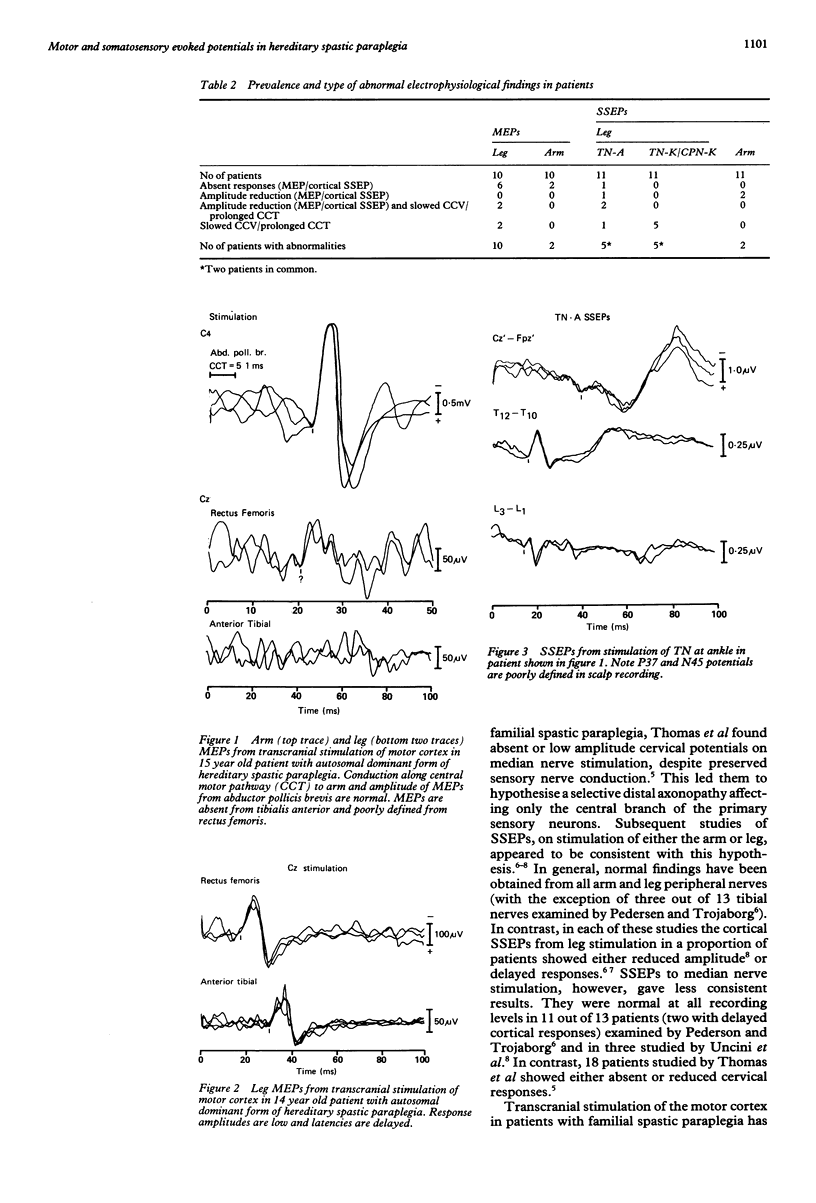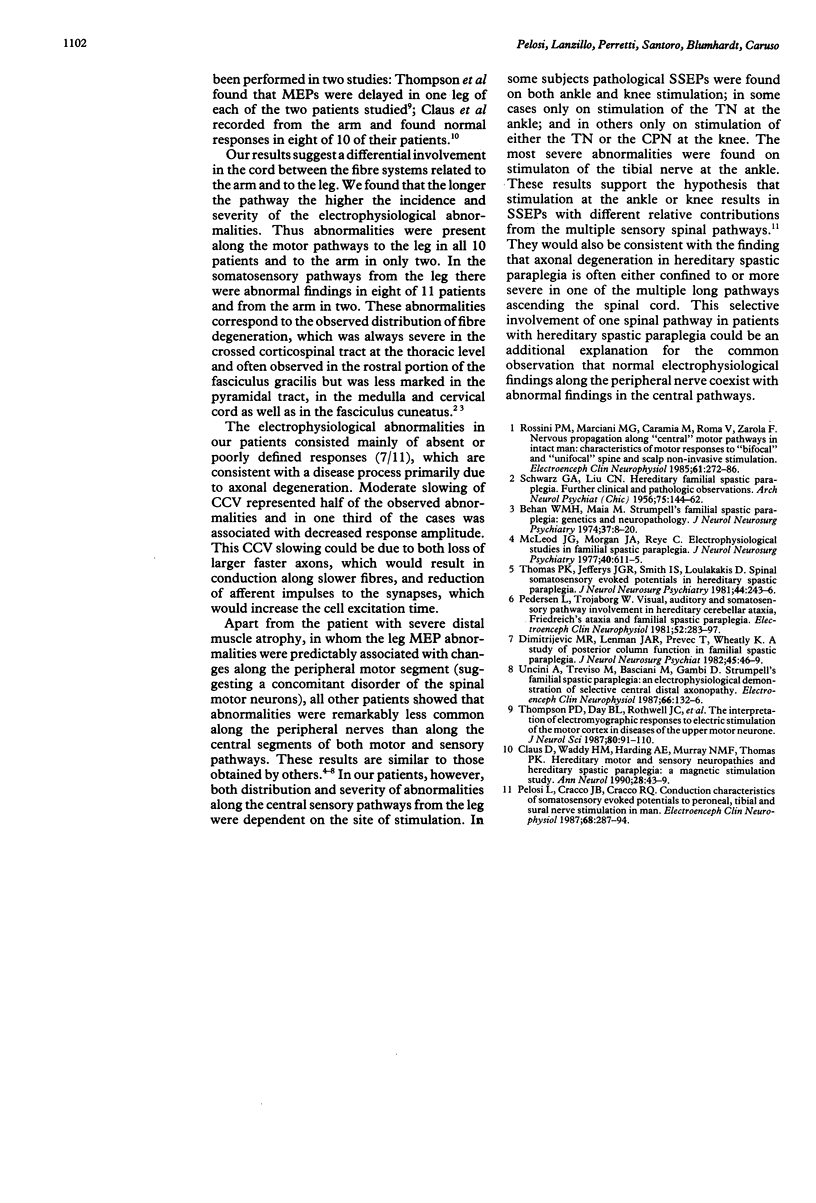Abstract
Motor evoked potentials (MEPs) from the arms and legs to transcranial stimulation of the motor cortex and somatosensory evoked potentials (SSEPs) from stimulation of the nerves of the arms and legs, were recorded in 11 patients with hereditary spastic paraplegia. Electrophysiological abnormalities were found to be distributed differently among the systems examined; the longer the pathway, the higher the incidence and severity of impairment. MEPs from the leg were either absent or clearly reduced or prolonged in all patients. Eight patients showed abnormal cortical SSEPs on stimulation of the leg (absent or reduced responses in four, slowed central conduction velocity in seven), but only two of these patients had abnormal MEPs from the arm (absent responses). Cortical SSEPs on stimulation of the median nerve were reduced in two patients. Mean values of amplitude and central conduction velocity for MEPs and SSEPs from the leg were significantly different between patients and controls. Such differences were not found for either MEPs or SSEPs from the arm. This distribution of abnormalities, which suggests a differential involvement of the spinal pathways, parallels the reported pathological pattern in which degeneration of axons is more common and severe in the motor and sensory fibres supplying the leg.
Full text
PDF



Selected References
These references are in PubMed. This may not be the complete list of references from this article.
- Behan W. M., Maia M. Strümpell's familial spastic paraplegia: genetics and neuropathology. J Neurol Neurosurg Psychiatry. 1974 Jan;37(1):8–20. doi: 10.1136/jnnp.37.1.8. [DOI] [PMC free article] [PubMed] [Google Scholar]
- Claus D., Waddy H. M., Harding A. E., Murray N. M., Thomas P. K. Hereditary motor and sensory neuropathies and hereditary spastic paraplegia: a magnetic stimulation study. Ann Neurol. 1990 Jul;28(1):43–49. doi: 10.1002/ana.410280109. [DOI] [PubMed] [Google Scholar]
- Dimitrijevic M. R., Lenman J. A., Prevec T., Wheatly K. A study of posterior column function in familial spastic paraplegia. J Neurol Neurosurg Psychiatry. 1982 Jan;45(1):46–49. doi: 10.1136/jnnp.45.1.46. [DOI] [PMC free article] [PubMed] [Google Scholar]
- Pedersen L., Trojaborg W. Visual, auditory and somatosensory pathway involvement in hereditary cerebellar ataxia, Friedreich's ataxia and familial spastic paraplegia. Electroencephalogr Clin Neurophysiol. 1981 Oct;52(4):283–297. doi: 10.1016/0013-4694(81)90057-2. [DOI] [PubMed] [Google Scholar]
- Pelosi L., Cracco J. B., Cracco R. Q. Conduction characteristics of somatosensory evoked potentials to peroneal, tibial and sural nerve stimulation in man. Electroencephalogr Clin Neurophysiol. 1987 Jul;68(4):287–294. doi: 10.1016/0168-5597(87)90049-9. [DOI] [PubMed] [Google Scholar]
- Rossini P. M., Marciani M. G., Caramia M., Roma V., Zarola F. Nervous propagation along 'central' motor pathways in intact man: characteristics of motor responses to 'bifocal' and 'unifocal' spine and scalp non-invasive stimulation. Electroencephalogr Clin Neurophysiol. 1985 Oct;61(4):272–286. doi: 10.1016/0013-4694(85)91094-6. [DOI] [PubMed] [Google Scholar]
- SCHWARZ G. A., LIU C. N. Hereditary (familial) spastic paraplegia; further clinical and pathologic observations. AMA Arch Neurol Psychiatry. 1956 Feb;75(2):144–162. doi: 10.1001/archneurpsyc.1956.02330200038005. [DOI] [PubMed] [Google Scholar]
- Thomas P. K., Jefferys J. G., Smith I. S., Loulakakis D. Spinal somatosensory evoked potentials in hereditary spastic paraplegia. J Neurol Neurosurg Psychiatry. 1981 Mar;44(3):243–246. doi: 10.1136/jnnp.44.3.243. [DOI] [PMC free article] [PubMed] [Google Scholar]
- Thompson P. D., Day B. L., Rothwell J. C., Dick J. P., Cowan J. M., Asselman P., Griffin G. B., Sheehy M. P., Marsden C. D. The interpretation of electromyographic responses to electrical stimulation of the motor cortex in diseases of the upper motor neurone. J Neurol Sci. 1987 Aug;80(1):91–110. doi: 10.1016/0022-510x(87)90224-3. [DOI] [PubMed] [Google Scholar]
- Uncini A., Treviso M., Basciani M., Gambi D. Strümpell's familial spastic paraplegia: an electrophysiological demonstration of selective central distal axonopathy. Electroencephalogr Clin Neurophysiol. 1987 Feb;66(2):132–136. doi: 10.1016/0013-4694(87)90182-9. [DOI] [PubMed] [Google Scholar]


